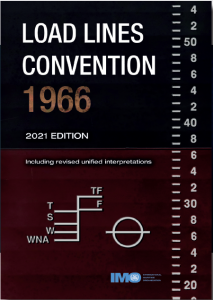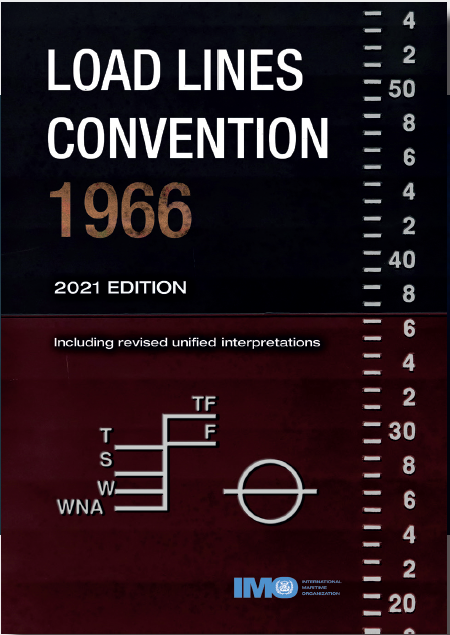The International Load Line Convention establishes a universal system of load lines for ships, aiming to safeguard life at sea and protect marine environments by preventing overloading. This convention outlines the minimum freeboard, ensuring that ships maintain adequate stability and sufficient reserve buoyancy.
The Convention was initially adopted in 1930 and underwent several amendments to address the evolution in ship design and technology. The most recognized version was adopted in 1966 and incorporated amendments proposed by the IMO, aiming for consistency and efficacy in implementation. This section defines key terms such as “Freeboard,” “Plimsoll Line,” “Reserve Buoyancy,” and “Load Line,” clarifying the language used throughout the Convention to avoid ambiguities.
The Convention applies to ships engaged in international voyages, stipulating specific exemptions for particular ship types, including warships, fishing vessels, and ships operating solely within sheltered waters. National maritime administrations are responsible for enforcing the Convention’s provisions, conducting surveys, and issuing Load Line Certificates. The administrations also ensure compliance through regular inspections and addressing violations appropriately.

Conditions of Assignment of Freeboard
Determination of Freeboard: This section provides guidelines for calculating the minimum freeboard, considering various factors such as ship type, size, construction, and operational conditions.
Conditions Affecting Freeboard Assignment: The assignment of freeboard is influenced by the ship’s structural integrity, presence of superstructures, and the type and arrangement of openings, ensuring the ship’s ability to withstand water ingress.
Weather Criteria: Ships must comply with specific weather criteria, including the ability to withstand adverse weather conditions, waves, and wind, thus ensuring the ship’s seaworthiness in different operational zones and seasons.
Superstructure and Structural Members: The design and condition of superstructures and structural members, including bulkheads and deckhouses, affect the assignment of freeboard, ensuring adequate strength and watertight integrity.
Openings in Freeboard and Superstructure Decks: The Convention outlines requirements for openings such as hatches, doors, and air pipes, ensuring they are adequately protected to prevent water ingress, thereby maintaining the ship’s buoyancy and stability.
Freeboards
Minimum Freeboard Calculation: The minimum freeboard is calculated based on the ship’s design, operational conditions, and structural features. This section provides formulas and tables to determine the appropriate freeboard, ensuring compliance with safety standards.
Correction Factors: Correction factors are applied to account for variations in ship design, construction, and operational conditions, allowing for adjustments in freeboard calculations to accommodate specific ship characteristics.
Type of Ships and Freeboard Assignment: Different ship types, such as cargo ships, passenger ships, and tankers, have distinct freeboard requirements. This section categorizes ships and outlines the specific criteria for assigning freeboard to each type.
Additional Requirements for Wood Ships: Wooden ships have unique characteristics and vulnerabilities, necessitating additional considerations in freeboard assignment. This section addresses the specific requirements and adjustments applicable to wooden ships to ensure their safety at sea.
Special Requirements for Ships Assigned Timber Freeboards
This chapter provides a comprehensive overview of special regulations pertaining to ships carrying timber decks cargoes. Due to the nature of such cargoes, additional freeboard assignments and specific measures are needed to maintain stability and seaworthiness.
Timber Deck Cargoes are defined by their characteristics, including types of timber, forms (logs, sawn wood, etc.), and their arrangement on deck, which influence the ship’s stability and necessitate special requirements.
Criteria for Assigning Timber Freeboards: Several criteria, including the ship’s size, cargo arrangement, and securing methods, are considered when assigning timber freeboards to ensure the vessel maintains adequate stability and structural integrity.
Stability Considerations: Given the high center of gravity of timber deck cargoes, the chapter delves into stability assessments, incorporating criteria such as the metacentric height (GM) and the righting levers (GZ) to ascertain the ship’s seaworthiness.
Securing and Stowing of Timber Cargoes: Guidelines are detailed on appropriate stowing and securing methods for timber cargoes to prevent shifting, which could compromise the ship’s stability. This includes lashings, gripes, and other securing mechanisms in accordance with best practices and international standards.
Zones, Areas, and Seasonal Periods
Geographical Zones and Areas: This chapter delineates the various geographical zones and areas defined in the Convention. Different zones such as tropical, summer, winter, and winter North Atlantic have different freeboard requirements due to variations in environmental conditions.
Seasonal Variations and Adjustments: Depending on the season, ships may be required to adjust their freeboards to account for changes in sea conditions. This section elaborates on the adjustments required for different seasonal periods and geographical areas.
Load Line Marks and Their Significance: This section explains the significance of different load line marks corresponding to the various zones and seasonal adjustments, providing clarity on how to interpret and apply them for compliance.
Compliance and Enforcement in Different Zones: The chapter addresses the mechanisms for compliance and enforcement of the freeboard regulations across different zones and areas, including the role of port State control and the obligations of flag States.
Surveys and Marking
Survey Types and Frequency: This chapter specifies the different types of surveys, such as initial, annual, intermediate, and renewal surveys, required under the Convention. The frequency and scope of each survey are detailed to ensure ships’ ongoing compliance with the load line requirements.
Verification of Compliance: The verification process to ensure compliance with the Convention’s requirements is thoroughly explained, encompassing inspections of the ship’s structure, equipment, and load line marks.
Issuance and Endorsement of Certificates: Upon satisfactory completion of the required surveys, the appropriate certificates are issued by the authorized organizations or the Administration. The procedures for the issuance, endorsement, and renewal of International Load Line Certificates are outlined in detail.
Maintenance of Conditions After Survey: The chapter emphasizes the importance of maintaining the ship in compliance with the Convention’s provisions between surveys. It outlines the shipowners’ and masters’ responsibilities and the implications of non-compliance, including potential penalties and corrective actions.
Determination of Load Lines
This chapter elucidates the foundational principles guiding the determination of load lines. This involves assessing the structural strength of the ship, its stability characteristics, and the probable environmental conditions it might encounter in different zones and seasons.
Calculation Methods and Considerations: In-depth exploration of the methods used to calculate the appropriate load lines is provided. Factors such as the ship’s type, size, construction, and purpose, as well as the nature of the cargo, are taken into consideration during this process.
Deck Line and Freeboard Measurements:The chapter details the procedures and formulas used to measure the deck line and establish the correct freeboard, ensuring that the ship maintains adequate buoyancy and stability in various conditions.
Positioning of Load Line Marks:Guidelines for the correct positioning of load line marks on the ship’s hull are laid out, ensuring visibility and accuracy. The marks denote the maximum depth to which a ship can be loaded, considering the water type and temperature in different geographical zones.
Compliance and Verification:The mechanisms and procedures for verifying compliance with the determined load lines are elucidated. This includes inspections, documentation, and the responsibilities of the ship’s master and the relevant authorities.
–
Limitations on Draught and Depth
Determination of Maximum Draught: This chapter explores the factors and calculations involved in determining the maximum permissible draught of a ship. The considerations include the ship’s design, the nature of its cargo, and the environmental conditions of its operational areas.
Depth Considerations: Depth considerations are essential for the safety of the ship and its cargo. The chapter provides comprehensive insights into how the depth of a ship is measured and the limitations imposed based on various factors such as ship type and cargo.
Impact on Stability and Subdivision: A discussion on how the limitations on draught and depth affect the stability and subdivision of the ship is included. The correlation between these factors and the ship’s overall seaworthiness and safety is thoroughly examined.
Compliance Measures: The chapter concludes with the measures taken to ensure compliance with the limitations on draught and depth. These include regular surveys, inspections, and the roles of both the ship operators and regulatory bodies in enforcement.
Penalties and Measures for Contravention
Penalties for Non-Compliance: This chapter details the range of penalties and consequences that may be imposed for contravention of the Convention’s regulations. Penalties may include fines, detention of the ship, and other legal repercussions depending on the severity of the violation.
Detection of Contraventions: Methods and procedures for detecting contraventions are outlined. This includes regular inspections by port State control, reporting mechanisms, and the responsibilities of the flag State and other relevant authorities.
Rectification Measures: The chapter provides insights into the measures that must be taken to rectify any contraventions. This involves corrective actions, re-inspections, and potential modifications to the ship’s structure or operations.
Appeals and Dispute Resolution: Finally, the chapter discusses the avenues available for appealing against imposed penalties and the mechanisms in place for resolving disputes between the involved parties. The roles of international maritime bodies, national authorities, and the judiciary are highlighted in this context.

